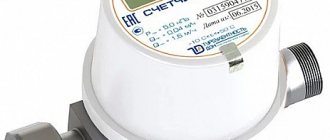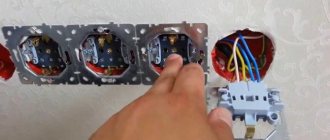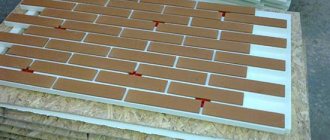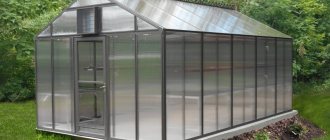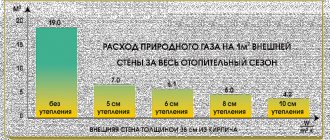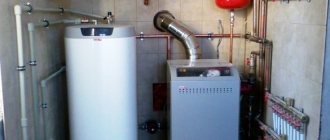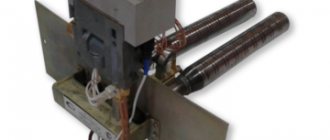A dielectric coupling is a cut-off fitting that protects the “brains” of gas-consuming devices from the destructive effects of stray currents. That is, we have before us a very useful unit, the effectiveness of which has been proven by the definition itself. However, many owners of gas stoves, water heaters and boilers, as well as employees of gas services, do not know about the existence of such an insert. And in this material we will try to eliminate this gap in knowledge by talking about the benefits of dielectric fittings, its varieties and installation methods.
Types of gas hoses
If we consider gas hoses, we should divide them into three types, which differ in the material of manufacture. Thus, bellows eyeliners can be found on sale; rubber sleeves, which are equipped with a metal braid; as well as rubber-fabric elements. Flexible liner based on rubber-fabric sleeves is the softest; this quality can be called negative, since mechanical rigidity is at a minimum level. The advantage is that rubber products are not capable of conducting electric current. Hoses with metal braid are more common among consumers today. The reason for this popularity is expressed in low cost. This type of gas hose differs from hoses intended for water in that a yellow stripe can be found on its surface. Flexible bellows-type hose is characterized by maximum rigidity and reliability among other types of hoses. For such a product you will have to pay the highest price; regulatory documentation recommends the installation of products of this particular type. This is due to the fact that such a material copes excellently with the effects of high pressure created by the gas flow.
Bellows Gas Hose: Best for Gas Stove
If you ask a specialist what type of hose for a gas stove should be, most likely he will suggest purchasing a bellows version for installation. This type of hose is considered the most reliable for connecting the hob to the central gas supply. In addition to gas stoves, it is used to connect water heaters and gas boilers used for individual heating. A bellows is an elastic corrugated shell that protects the inner layer from mechanical and other types of damage.
The great demand for bellows hoses is due to the high technical characteristics and reliability of the devices. The products easily withstand the high pressure created by the gas flow in the pipe. Ease of connection is provided by two fittings designed for connection to a gas pipe and directly to the device. All hose components are made from high-quality stainless steel, which guarantees maximum service life.
The bellows gas hose is considered the most reliable for connecting the hob to the central gas supply
The price of a gas hose for a gas stove of this type is significantly higher than the cost of other product options, but the service life is at least 10 years longer than the service life of other devices. So, the minimum time during which you can safely use a bellows hose is 25 years, although some companies give a 30-year warranty. The final price is usually influenced by the manufacturer and size of the product.
You can find out how much a gas hose for a gas stove costs (depending on the characteristics) from this table:
| Connector diameter, inch | Length, m | Price, rubles |
| 1/2 | 0,4 | from 250 |
| 0,8 | from 290 | |
| 1 | from 320 | |
| 1,5 | from 400 | |
| 3 | from 780 | |
| 4 | from 950 | |
| 5 | from 1150 | |
| 3/4 | 0,6 | from 350 |
| 1 | from 450 | |
| 2 | from 700 | |
| 2,5 | from 900 | |
| 3 | from 1050 |
The main advantages and disadvantages of using bellows hoses
Simple models of bellows hose are presented in the form of corrugated products, which are distinguished by the presence of a round cross-section. If you choose a more expensive option, then in addition there will be a metal sleeve or polymer coating for protection. The modernized version of the bellows hose has a built-in thermal protection valve, which, when the temperature rises critically, independently shuts off the flow of gas. Of course, this option will also affect how much the hose costs, but the losses that can be incurred in the event of a gas leak will be much higher. Other advantages of bellows hoses:
- easily bend and stretch;
- can withstand loads up to 6 atm;
- are operated in a wide temperature range from -50 to +200 °C;
- are made of high-quality materials that comply with all GOST standards;
- meet the technical requirements for domestic use;
- maximum possible service life - up to 30 years from the date of installation;
- withstand the influence of electric current up to 1.5 kW;
- a large selection of hose lengths for connecting a gas stove - from 0.4 to 5 m;
- compatibility with most types of gas equipment and various accessories;
- the presence of a coating that protects the base of the hose from the effects of various household chemicals used for cleaning and disinfecting the kitchen.
Simple models of bellows hose are presented in the form of corrugated products
Additional safety for the hose is provided by an electrically insulating polymer layer, which protects not only from mechanical stress, but also from high-frequency currents that are created by some household appliances, for example, a microwave oven. Due to the strength of the hose, manufacturers guarantee the integrity of the connection even in the event of natural anomalies, such as an earthquake, when the stability of the building is compromised.
The only relative disadvantages include the price, which is several times higher than the cost of similar products from other groups. However, the presence of a large number of positive characteristics, which include a significant service life, covers this drawback.
Basic rules for the safe operation of flexible gas connections
Working with central gas supply devices requires special care, because the safety and life of the residents of the house depend on the correct connection and operation. The main rule when using a bellows-type gas hose is its open installation. The hose must not be hidden or covered with pieces of furniture or household appliances: the body of the hose, as well as its connection to the gas pipe, must always be visible
The hose must not be hidden or covered with pieces of furniture or household appliances: the body of the hose, as well as its connection to the gas pipe, must always be visible.
To hide the device, it is possible to use a collapsible box, which can be easily disassembled if necessary, but it is better to leave it uncovered. If you hide the product, you may not notice the beginning of the destruction of the product, which can lead to a gas fire. It is not recommended to use paints and varnishes to decorate the hose, which may damage the integrity of the outer layer.
To connect gas equipment, you should not use a hose that is too long or, conversely, very short.
It is important to note that after gas is supplied, due to the resulting pressure, the hose may become slightly shorter, and stretching the device after installation is strictly prohibited
After connecting the stove to the gas pipe, a slight sag of the sleeve is allowed, but you need to make sure that there are no kinks or twists. To avoid this, it is recommended to observe the bending radius, which is on average equal to three times the diameter. Other important rules:
Do not allow the hose to be constantly exposed to water or steam, which will cause oxidation of the metal. It is better to place the hob slightly away from the gas pipe. If a thread of a non-standard cross-section is installed in the plate, then it is additionally permissible to use an adapter for connection. Do not carry out welding or soldering work near the gas connection. If necessary, a heat shield is laid between the soldering iron and the gas hose
Before installing the bellows, be sure to pay attention to the presence in the packaging of documentation confirming the safety of using the product. When installing, you cannot join different materials together, for example, copper and steel. Steel can only be connected to steel, and copper can only be connected to copper or brass.
Do not use great force when tightening the connections, so as not to damage or strip the threads. To ensure a tighter fit, FUM tape is used. If you lack experience and self-confidence, you should not carry out work on installing a gas hose yourself.
Steel can only be joined to steel, and copper can only be joined to copper or brass. Do not use great force when tightening the connections, so as not to damage or strip the threads. To ensure a tighter fit, FUM tape is used. If you lack experience and self-confidence, you should not carry out work on installing a gas hose yourself.
Despite the fact that hoses are guaranteed for 15 to 30 years, it is recommended to inspect the product at least once a year for cracks. Using a soap solution, check the condition of the connections. If any defects are found, the hose should be replaced.
Bellows gas supply is considered one of the types of flexible hoses that are used to connect gas devices to the central pipe. Thanks to the flexibility and large selection of hoses of various lengths, there is no need to tie the equipment to the gas riser. Despite the fact that such a hose costs several times more than its conventional counterparts, due to its high quality, safety and long service life, bellows hoses have a large number of positive reviews online.
source
Correct installation
Installing a dielectric insert into a gas pipe
An insulating coupling or gas insert must be inserted between the gas tap and the bellows or other type of connection. It is necessary to install the element taking into account safety requirements; before starting the installation, you will need to turn off the tap and do not open it until all the necessary actions have been taken to eliminate possible leaks. Installation must be carried out by gas service employees who have the appropriate qualifications and permission to perform this type of work. During installation you will need:
- Prepare a pair of adjustable wrenches, one of them is designed to hold the body from the valve, the second one needs to tighten the nut from the liner connecting the tube to the device running on gas fuel.
- Install any type of sealant, for example, polymer, on the ends of the insert, then place the dielectric inside the gas pipeline manually.
- Holding the valve with one key, tighten the second coupling or bushing until it stops; during the installation process, you need to be careful not to accidentally tear off the threaded coating and damage the body of the element.
- Screw the nut from the bellows-type hose to the other part of the coupling, while holding the insert with an adjustable wrench, and then tighten the connecting parts as tightly as possible.
When the standard gas dielectric is installed, you will need to check the joining areas for the level of tightness. For this purpose, use a small brush or brush, which is thoroughly soaped. The soap solution must be applied to each inlet, as well as the joint, then slowly open the gas tap. If there is foam or bubbles, turn off the tap and re-inspect the joint areas. It is possible to use the gas unit only after bubbles stop forming in the solution. In no case should the leak be checked using matches or a lighter; if there is a leak, fire may cause a gas explosion.
Connecting equipment to a gas pipe using a dielectric insert
The installation of gas units and additional components is carried out with particular precision, since the safety of the building’s occupants directly depends on the correct connection of the parts. The hoses are installed according to the principle of open installation; the hoses should not be hidden or covered with furniture or household appliances; the element itself, as well as the dielectric bushing or gas coupling, must be mounted from the outside. To connect the equipment, do not use hoses that are too long or shortened, since due to pressure this part may become shorter; in addition, it is forbidden to stretch it. The hose may sag after joining the pipe, but it must not be twisted or kinked.
When installing a dielectric adapter for household gas, you need to make sure that the hose does not get steam or water, which can provoke oxidation of metal parts. Cooking surfaces are placed away from the gas pipeline pipes; if there are atypical threads in the stoves and other equipment, adapters are used for connection.
Popular manufacturers
You can choose a suitable insulator designed for gas supply from Russian or imported dielectrics.
The most popular parts are from the Turkish brand Tuboflex; this company offers couplings and bushings with various types of threads and at an affordable price.
The inserts of the Italian manufacturer UDI-GAS have earned a good reputation for offering innovative connections equipped with additional protective layers.
Source – https://strojdvor.ru/gazosnabzhenie/raznovidnosti-i-preimushhestva-dielektricheskix-gazovyx-vstavok/
Selection of gas fittings
Various fittings for gas equipment and connecting individual elements of the system are not suitable for every pipe. Connection to the gas pipeline and its branching to the points where various devices operating on blue fuel are installed is carried out by those products that are most suitable for each other.
For steel pipes
If a steel pipe is used when installing a gas pipeline system, fittings for it are taken from the same material. The size of the elements is ½ inch, which is enough for an unhindered gas supply.
The fitting and steel pipe are connected in two ways - threaded detachable and welded one-piece. The second method is used for joining and fastening together the structural parts of the gas pipeline by welding them with a circular seam between adjacent elements or using electric arc technology.
If it is necessary to create a temporary connection at the connection point of a gas stove or boiler, the threaded method is used. To begin with, a bend with turns is cut on the pipe using a die. To ensure tightness, a sealant (fum tape, tow) is placed over the entire area. Screw on the locknut and then the fitting. Fastening points for gas equipment are made in the same way, connecting the fitting to the thread on it.
It is necessary to paint the pipe to prevent its destruction under the influence of harmful factors. You can choose any color indoors, but outdoor areas are usually painted yellow.
For polyethylene pipes
When creating a gas supply from polypropylene pipes, plastic fittings are used and connected by welding. This system is durable and airtight. To carry out all the work you will need special equipment. During the installation process, adjacent elements are heated and glued together, becoming a single whole.
To create a detachable connection, combined fittings are used, which on one side are a polypropylene base, on the other - a metal thread. First, one side is welded, and then the gas equipment is connected by screwing the coupling onto turns.
Due to the need to connect pipes of different diameters, connecting elements are produced in different sizes.
For metal-plastic pipes
When working with metal-plastic pipes, brass fittings are used, which have high strength and a long service life. As in the case of metal and polypropylene systems, fastening is carried out using a permanent and detachable method using various products.
The most reliable and easiest to use are press fittings equipped with a special capsule around the fitting.
Connecting a gas water heater to a gas pipeline: educational program
Which gaskets are best to use?
Quite often, a muffler exhaust pipe flange gasket is used for replacement, which is responsible for sealing the connection between the exhaust pipe of a car exhaust system and the exhaust manifold.
This gasket is usually used on cars that have a receiving pipe mounted at two points (Volga third series, GAZ-21). However, you can make your own pant liner. It is recommended to use the following materials:
- Sheet copper;
- Asbestos;
- 2nd layer of copper.
Also, many motorists advise using automotive sealant that can withstand high temperatures. The technology for using it is quite simple: a thin layer (about one millimeter thick) is applied to the muffler in the seat, and then left to dry for twelve hours.
Most drivers prefer to use paronite to create a gasket. The creation process is as follows:
- First, a square-shaped piece of material is cut out, the old gasket is placed on it and placed on superglue.
- Then a marker is drawn along the entire contour. It is also necessary to circle all the holes located inside the product.
- The old gasket is removed, and then all the glue is removed.
- Next, the correct hole ratio is checked. If a discrepancy occurs, the product must be refined using a file.
There is an easier way:
- The surface on which the gasket will be present is cleaned and degreased;
- The gasket material is applied.
- Next, the product is hammered around the entire perimeter with a hammer.
- The gasket will gradually become visible, and the unnecessary part of the material will fall behind.
Types of dielectric cut-offs
Let's take a closer look at the types of dielectric cut-offs
.
In everyday life, two types of dielectrics are used for a gas hose or pipe: simple bushings that resemble liners, and threaded couplings. Let's look at how the inserts differ and choose the best solution for installation on our own.
Option #1 – bushings
Let’s say right away that you won’t need bushings to install a gas stove or install a water heater, since they don’t have much other purpose. The task is the same - to protect against stray currents.
But they are mounted where there are flange connections and bolts are used. To put it simply, bushings are used for electrical insulation of flange fasteners.
Dielectric inserts are made of PA-6 polyamide. They are resistant to external influences and have a long service life.
_
Exploitation
— the stage of an object’s life cycle at which its quality (working state) is implemented, maintained and restored. (GOST R 51617-2000)
Technical characteristics of gas bushings:
- elasticity and high degree of adhesion to metal elements;
- ability to withstand multiple alternating loads.
- frost resistance - can withstand low temperatures down to -60 ° C;
- petrol and oil resistance at temperatures up to +120 °C;
Products are marked by diameter in mm, for example, from M 8 to M 24. There you can also specify the height of the collar and the length of the bushings. The manufacturer indicates the diameters of suitable flanges, bolts, and washers in special tables.
Option #2 – couplings
That’s why installers often call them just that – couplings; universal insulating inserts for gas pipes are attached using the coupling method. They differ in the type of thread, diameter, material of manufacture, external design, but they still perform the same function - they cut off the currents generated on the gas pipe from the equipment.
Inserts are manufactured at the factory in accordance with GOST or TU. They are produced in special molds in an automatic way, using screw extrusion of two materials: metal for threaded pipes, insulating polymer. The polymer material meets the requirements of GOST 28157-89.
_
Material
- any ingredients, raw materials, components, parts, etc. used to manufacture the product.
The products are intended for operation at a working pressure of 0.6 MPa; the critical value is 1.2 MPa. The average operating temperature is from -20 °C to +80 °C.
On sale you can also find products with a black polyamide part, gas
belong to group 4 (flammable gases) and are marked in yellow.
It is better to purchase products from well-known brands rather than Chinese counterfeits, and choose products based on the following criteria:
- suitable technical characteristics - a resistance of at least 5 Ohms with a sharp increase in voltage to 1000 V.
- fire safety - threaded metal elements do not burn, and plastic ones do not support combustion;
- wear resistance and durability - high-quality parts are made of brass and have a 20-year service life;
_
Combustion
- an exothermic reaction that occurs under conditions of its progressive self-acceleration. (GOST 12.1.044-89)
Durability
- a characteristic (parameter) of products that determines their ability to maintain performance qualities for a given period, confirmed by the results of laboratory tests and expressed in conventional years of operation (service life). (GOST 23166-99); — housing and communal services - the property of equipment and heating networks to remain operational until the onset of a limit state with an established system of maintenance and repair. (MDS 41-6.2000)
The best place to install the coupling is between the gas tap and the flexible connection.
The connection method is threaded, and occurs by screwing the device onto the pipe. The fittings can have both external and internal threads.
_
Device
- a set of elements representing a single structure (multi-contact relay, set of transistors, board, block, cabinet, mechanism, dividing panel, etc.). The device may not have a specific functional purpose in the product. (GOST 2.701-84)
Before purchasing a dielectric, you need to check the diameter of the gas pipe, as well as select a flexible connection that is suitable in size. Therefore, do not forget to check the package, sometimes connection hoses are sold along with the equipment.
Constantly under the control of the gas service, which conducts equipment inspections annually, gas
is installed for a long time and does not require maintenance.
The procedure for installing a dielectric on gas
Before any work on gas equipment or lines, it is necessary to turn off the tap to stop the flow of fuel and ensure safety. If the stove, heater or boiler was used before, you need to leave the burners in working order so that the remaining gas burns out.
Then we proceed in order:
If the flexible hose is already attached to the pipe, use a wrench to carefully twist the nut
Fasteners that have been installed for a long time often “stick”, so to be sure, you can use two keys. We wrap a sealant - fum tape - around the free end of the pipe and carefully tighten the connection, first by hand and then with a wrench. We screw the coupling or “barrel” as far as possible, being careful not to knock off the threads or deform the dielectric body. In the same way, screw the flexible line nut onto the other end. We diagnose the connection in a safe way.
A soap solution is used not only by users of gas equipment, but also by Gorgaz employees to check the tightness of connections. Diagnostics is simple: apply soap foam with a shaving brush or brush to the joints and observe what happens.
The appearance of bubbles, even small ones, indicates a lack of tightness - the coupling will have to be tightened. If there are no bubbles, the installation was completed correctly and you can safely use the equipment.
It is prohibited to use open flames such as matches or lighters to check for gas leaks.
A dielectric coupling is a cut-off fitting that protects the “brains” of gas-consuming devices from the destructive effects of stray currents. That is, we have before us a very useful unit, the effectiveness of which has been proven by the definition itself. However, many owners of gas stoves, water heaters and boilers, as well as employees of gas services, do not know about the existence of such an insert. And in this material we will try to eliminate this gap in knowledge by talking about the benefits of dielectric fittings, its varieties and installation methods.
Such currents appear in the ground due to an accidental breakdown of a household or industrial power line. The source of stray voltage can be either a ground loop or an electrified railway or tram line. This current enters the gas pipeline due to the difference between the resistivity of the earth and the metal parts of the gas supply line. In fact, all electricity discharged into the ground does not go into the ground (it has too much resistance), but into uninsulated cables or metal structures. And since most of the main and household gas pipelines are made of metal, the appearance of stray current in the system is only a matter of time.
Stray current protection
The main pipe can become a source of stray voltage in a household gas pipeline. To protect the gas supply pipeline from corrosion, the line is loaded with an electrical potential of insignificant strength, which suppresses the natural process of electrochemical splitting in the structural material. And if a breakdown of the dielectric insert for gas occurs in the common insulator separating the main line from the household branch, then the useful protective potential will turn into an unwanted stray current.
In addition, stray voltage may appear in the internal gas supply line due to poor grounding of the circulation pump or other electrical appliances in contact with the heating system wiring or the home gas pipeline branch. Another reason for the appearance of such currents may be an error when installing a boiler, water heater or gas stove connected to the electrical network. As you can see, stray current is not a myth, but a real problem. And the metal structure that falls under its influence turns into a serious threat to the safety of all residents of the house connected to the gas pipeline.
How to install the coupling - proceed carefully
Clause 6.4 of the set of rules SP 42-101-2003 indicates that the MD and VD must be installed between the gas distribution valve and the consuming appliance, therefore, when installing dielectric cut-offs, the following sequence of actions is used:
- We close the valve on the metal pipe supplying gas to the stove, boiler or column. In this case, it is better to leave the burners of the devices open so that the gas in the supply burns out.
- Holding the valve body with the first adjustable wrench, carefully twist the supply nut with the second wrench - a flexible pipeline (hose) connecting the shut-off unit to the gas inlet pipe of the boiler, stove or column. The use of a pair of keys in this case is mandatory, since the supply nut can “stick” to the fitting or branch pipe of the valve and transmit torque to it, after which gas will rush into the room, and its supply can only be shut off with a street reducer valve.
- We screw the FUM coupling (polymer seal) onto the free ends of the coupling and screw it into the gas pipeline valve by hand. Next, take the same two keys and, holding the valve body, screw in the coupling until it stops. Be careful not to overdo it at this stage, as too much force will cause the valve body to deform and cause gas to leak.
- We screw the supply nut to the device consuming gas onto the free end of the coupling, controlling our force and holding the fitting with one of the adjustable wrenches.
- Next, you need to check the tightness of the resulting connection. To do this, you need to purchase a shaving brush and, after thoroughly lathering it, treat all the joints of the valve, coupling and supply. After this, you open the valve and observe the foam at the joints. If you do not see any bubbles, the joints are sealed and your gas pipeline is ready for safe operation.
If soap bubbles are detected at the joints, you must shut off the gas supply valve and carefully tighten the coupling or supply nut. If this does not help, you will have to disassemble the entire connection and add several turns of FUM to the ends of the coupling.
Attention: the use of matches or lighters instead of soap foam when testing the tightness of joints is strictly prohibited. You may not have time to react and turn off the gas, causing a serious fire. And if there is a strong leak, you may be overwhelmed by panic - the sight of a flaming valve unbalanced even the most cold-blooded craftsmen. Therefore, the best leak tester is soap suds.
Purpose of a dielectric coupling for gas
Boilers and boilers are used to heat water in the heating system. For cooking, stoves, ovens and hobs are installed in the kitchen. The listed devices have a system of control sensors, electric ignition, and oven lighting. Therefore, the gas type of device requires connection to an electrical network.
To prevent current from flowing through the gas pipe indoors, polyamide insulators are used - couplings. For dielectric couplings for gas, yellow polyamide is used due to the low content of conductive impurities.
Dielectric insulating inserts, when current enters the gas network, will maintain the functionality of gas devices and gas meters.
Applications and functions of dielectric inserts
The absence of a dielectric insert can lead to a spark and gas detonation.
The gas dielectric coupling is a mandatory element, the presence of which is provided for by the rules governing the construction of gas distribution systems SP 42-101-2003. It must be present in pipelines of any type, including options with polyethylene pipes. If there is no such coupling, the stove, column or other electrical appliances can fail at any time after the appearance of stray current or become its cause. Sparks may occur inside the pipeline and cause a fire. Cases of spontaneous ignition of wiring occur quite often and can cause a major accident.
The process of detonation of the gas-air mixture may well destroy a multi-story building when the fire is not detected in time. When stray current appears inside pipes due to an emergency or during a thunderstorm, the risk of serious injury to owners of electrical appliances increases significantly. A dielectric coupling for each gas pipe must be installed in any building or apartment where gas-powered appliances connected to electricity are operated. In addition to its main functions, it prevents the formation of stray currents that arise due to problems during the installation of boilers, water heaters or gas stoves.
Gas hose life
The guaranteed service life of the gas hose is indicated in the instructions for use. After its expiration, the product is replaced. Depending on the material of manufacture and technical properties of the tubes, the following operational period is regulated:
- bellows hoses: 15-30 years, changes along with gas equipment;
- rubber-fabric: 2-3 years, if there is the slightest defect, the product requires replacement;
- reinforced: up to 10 years, they use high-strength materials;
- oxygen: up to 5 years, more often used to connect liquefied gas cylinders;
- rubber with metal braid: up to 10 years.
The service life is influenced by various factors: correct installation, correctly selected hose characteristics, product quality.
Basic technical properties of sealing tape
Video
FUM tape has the following characteristics:
- Reduced friction coefficient. The fluoroplastic seal, in addition to being plastic, is slippery, which simplifies the screwing of fittings.
- Thermal stability, allowing to withstand temperatures up to 260 degrees without destruction and loss of sealing properties. In addition, fluoroplastics are very effective dielectrics.
- Strength and ductility. Seals made of this material operate stably at pressures of up to 10 MPa and are able to withstand short-term loads of up to 42 MPa, for example, those occurring during water hammer in pipeline systems. The service life of a seal made from FUM tape (fumka) is determined to be 13 years. It degrades faster when exposed to light, but this is not for our case; we just need to take this factor into account when organizing the storage of the material.
- Chemical passivity. Without being subject to destruction under the influence of acids and alkalis, which is determined by the uniform distribution of fluorine atoms over the surface of the product. To date, no solvents capable of destroying this seal have been invented. Resistant to rotting processes.
Let's look at how to use FUM tape for gas and plumbing pipes correctly in more detail.
Hose connections
To carry out gas distribution, you can use not only pipes, but also rubber hoses. However, these must be special two-layer hoses made of vulcanized rubber
. Between their layers there should be textile reinforcement. Such hoses are used when connecting a cutter or torch to gas cylinders.
Fittings of the required diameter are used as fittings connecting gas hoses. The hose must be pulled firmly onto the fitting and secured with an aluminum clamp.
To facilitate the assembly of a gas line made using a hose, grease should be applied to them before connecting the hoses. The same substance seals the connection.
When connecting the reducer to a gas cylinder, a connection consisting of a union nut and a gasket is used. As a rule, in this case a gasket made of fluoroplastic is used. If the latter is lost or destroyed, vulcanized rubber can be used instead.
Application of anaerobic sealant.
- The operating temperature for which the sealant is intended.
- The maximum thread diameter that can be sealed with this sealant.
- Force is required for disassembly - there are sealants with light, medium and high disassembly force. Sealants with high dismantling force are used for large thread diameters (2.5 inches or larger). Before disassembling, such a connection must be heated.
Instructions for using anaerobic sealants are given in the video below:
Anaerobic sealants are used in water supply, heating and gas pipelines. The operating temperature range usually ranges from -60º to 150° C. Sealants are resistant to aggressive environments and can be used together with non-freezing coolants.
Metal-plastic for gas
Metal-plastic pipes can also be used for gas supply. The inside of pipes of this type is made of polyethylene, which is already familiar to us.
Due to the fact that metal-plastic pipes are supplied in coils, it becomes possible to lay a fairly long gas pipeline without using a large number of connections.
If the pipes still need to be connected, then only press fittings must be used. With their help, you can ensure the tightness of the connection, which will retain its properties for a long time. However, to make such a connection you will need a special device.
Installation rules
The assembly of protection units is carried out in the factory. When installing a unit on an existing gas pipeline, all safety requirements and technical rules for working with gas installations must be observed.
Insulating insert
The finished assembly is tested for resistance and tightness in the laboratory, about which a corresponding record is made. Installation is carried out by welding, after which the quality of electrical separation of the sections is checked. The evaluation criterion is the value of electrical resistance, which must be at least 5 ohms and provide a voltage drop of at least 5 mV when measured at different ends of the flanges.
The finished connection is isolated from possible contact with the ground or structural elements using aprons, boxes or similar means.
Acceptance of an insulating connection into operation is documented by a corresponding entry in the journal and a certificate.
Conclusions and useful video on the topic
Now you know everything - or almost everything - about the purpose and materials for insulating various steel gas pipelines, and also have an idea about the features of their application and checking the quality of protection.
And for greater clarity, we suggest watching a video that describes in detail how to insulate welded joints with bitumen-polymer tape:
Installing a heat-shrinkable sleeve on a weld seam:
Perhaps you have already encountered similar work, observed its implementation or took direct part. Please add or evaluate the information provided. We'd love to hear your thoughts in the discussion below.
